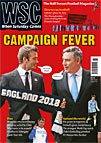 Joel Richards reports on the continuing difficulties in controlling Argentinian groups, both inside and outside the country
Joel Richards reports on the continuing difficulties in controlling Argentinian groups, both inside and outside the country
“I paid up,” shrugged Oscar Ruggeri. “I paid up loads of times,” admitted the World Cup winner on national television. As other guests on set were dismayed at his honesty, Ruggeri calmly replied. “What do you want me to do, lie? I had to pay up, but I didn’t give any money in 1986. I had just moved from Boca to River and they burnt my house down. What else could they do to me?”
Ruggeri’s honesty brought out into the open the issue of how the feared Argentinian hooligan groups, barra bravas, finance trips to the World Cup. Ruggeri admitted what few are willing to admit – that one way the barras raise cash, via threats and intimidation, is directly from the players. More than just violent groups of supporters or individuals, however, the barras make up the fabric of football clubs in Argentina. They have close links to the board and players, and take charge of the stadium and surroundings on matchdays, with all the economic benefits that go with controlling ticket touting, parking, hamburger stalls and fake replica shirt sales.
Every four years, the lucrative operation run by the barras translates into the money to travel to the World Cup and tickets for matches at the tournament. It is also the source of internal battles. Already this year there have been six deaths related to barras violence and there is little prospect of the atmosphere calming, with the ultimate prize of going to South Africa so close. This surge in violence is not at the stadiums and it is not between rival sets of fans, but it is a war fought on the streets.
With the prohibitive cost of World Cup tourist packages in Argentina, the barras have to find alternative means to travel. In an unprecedented move, covered in WSC 276, the government tacitly supported the creation of Hinchas Unidas Argentinas (HUA – United Argentinian Fans). Hundreds of barras would travel to the World Cup in return for political support on the terraces and a signed “peace agreement” to reduce violence surrounding the game.
With government backing, HUA flags appeared at games with an image of a penguin – the symbol of previous president Néstor Kirchner. The penguin recently disappeared, however, as there was no money coming from the government. The organisation is still in operation and planning to travel but the source of the funding is unclear. Sixty-four clubs were initially involved in HUA, but that figure is down to 42.
Many larger barras, like River Plate’s Borrachos del Tablón and Boca’s La Doce, stayed away – they are financing themselves. According to the magazine Olé, the head of La Doce, Mauro Martin, approached the Boca squad ahead of the superclásico with River. “We are losing money because of the bad results,” Martin is reported as saying. “If it doesn’t improve, you [the players] will have to cough up because we are sending 40 [barras] to South Africa.”
While HUA work on raising the funds and individual barras pay for the trip themselves, there is a further ingredient in the mix. As fans watched goals from Lionel Messi, Carlos Tevez, Sergio Agüero and Maxi Rodriguez in the 4-0 win over Venezuela in Maradona’s debut as coach a huge banner read “Gracias AFA”. But they were not thanking the Argentinian football federation for appointing Maradona coach.
Around 300 members of splinter barras groups were given tickets for the game. Salvemos al Fútbol, an NGO working to rid the game of violence and corruption, denounced the fact that the tickets came directly from AFA. The AFA leadership wanted more vocal support at home games, something only possible with an “official barra”. As those barras sang during the game at River Plate’s Monumental, “this is the narigón’s barra”. Narigón, big nose, is the nickname of the national team’s general manager and former World Cup-winning coach, Carlos Bilardo. The fear is that this group, linked with the barras that travelled to the 1986 and 1990 World Cups, will have “official” backing to travel to South Africa.
A recent Daily Mail article suggested that the Argentinian barras are organising to fight with the England fans over the Falkland Islands/Malvinas dispute. Mónica Nizzardo, of Salvemos al Fútbol, doubts this is necessarily the case. “The issue of Malvinas is always present in Argentina, it’s not just now, and we have no new information that the barras are preparing for a clash. Meeting the English would just be a bonus for them. The real worry is what will happen between the barras,” before adding, with unnerving calm and normality, “but at least they won’t be armed over there”.
It is expected that twice as many will travel to South Africa as went to Germany, so up to 500 this year, and they will be from many different clubs. Eight Argentinian police officers will travel to help local police identify possible trouble-makers. But while the authorities will aim to deal with the immediate problem of clashes between Argentinian fans, or with other nationalities, in South Africa, the real problem remains – how to eradicate the barra bravas from Argentinian football.
From WSC 279 May 2010